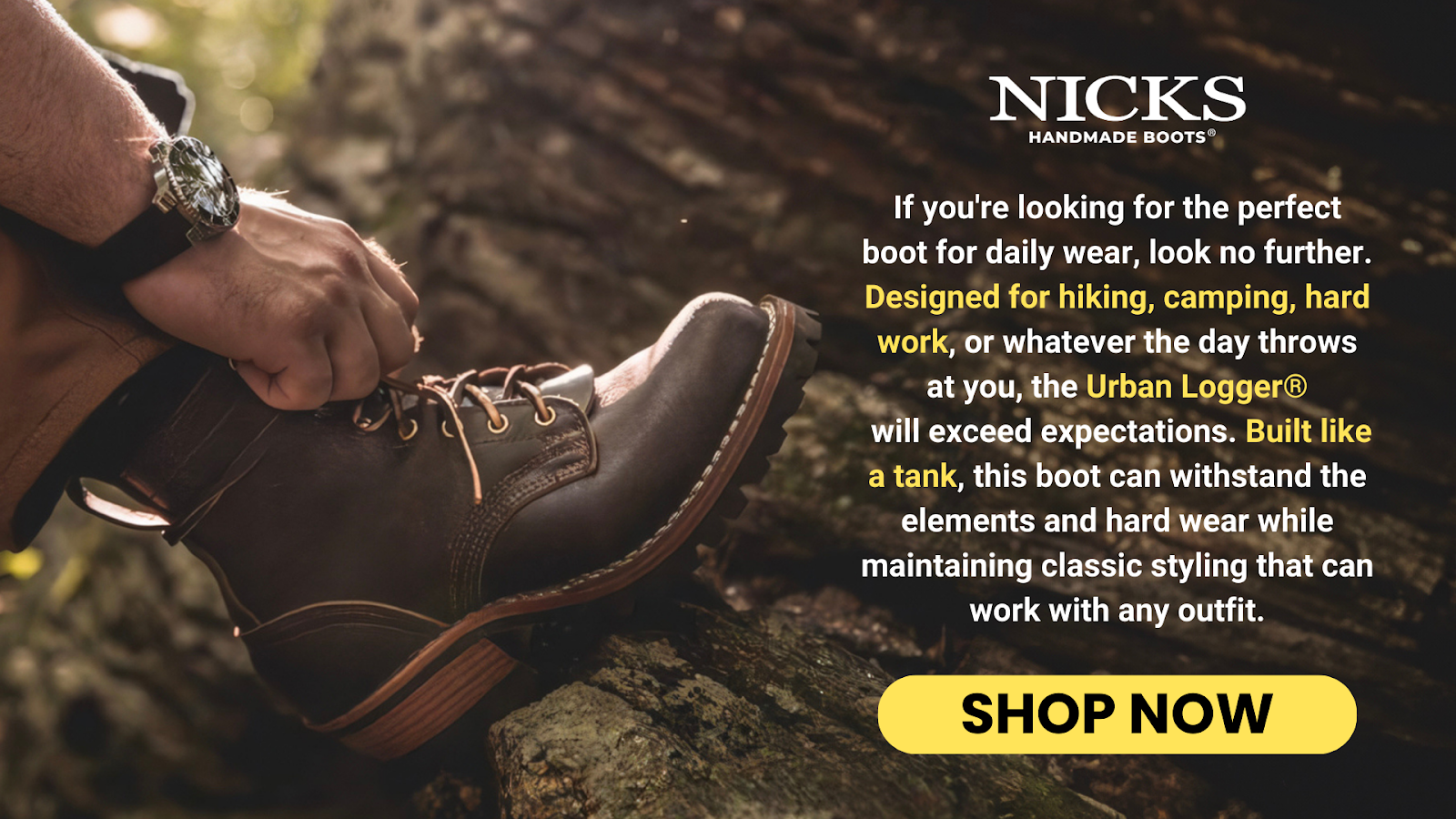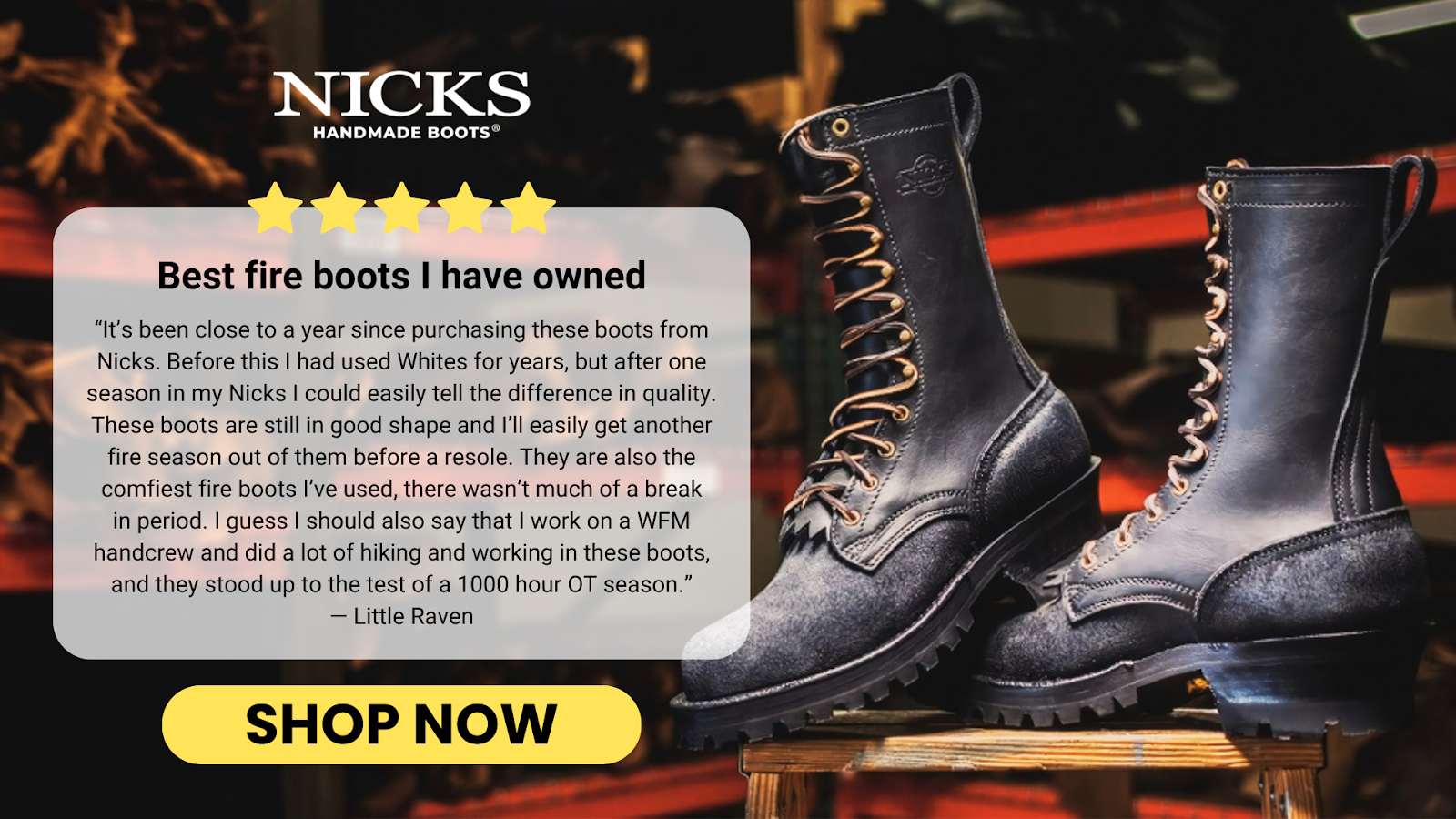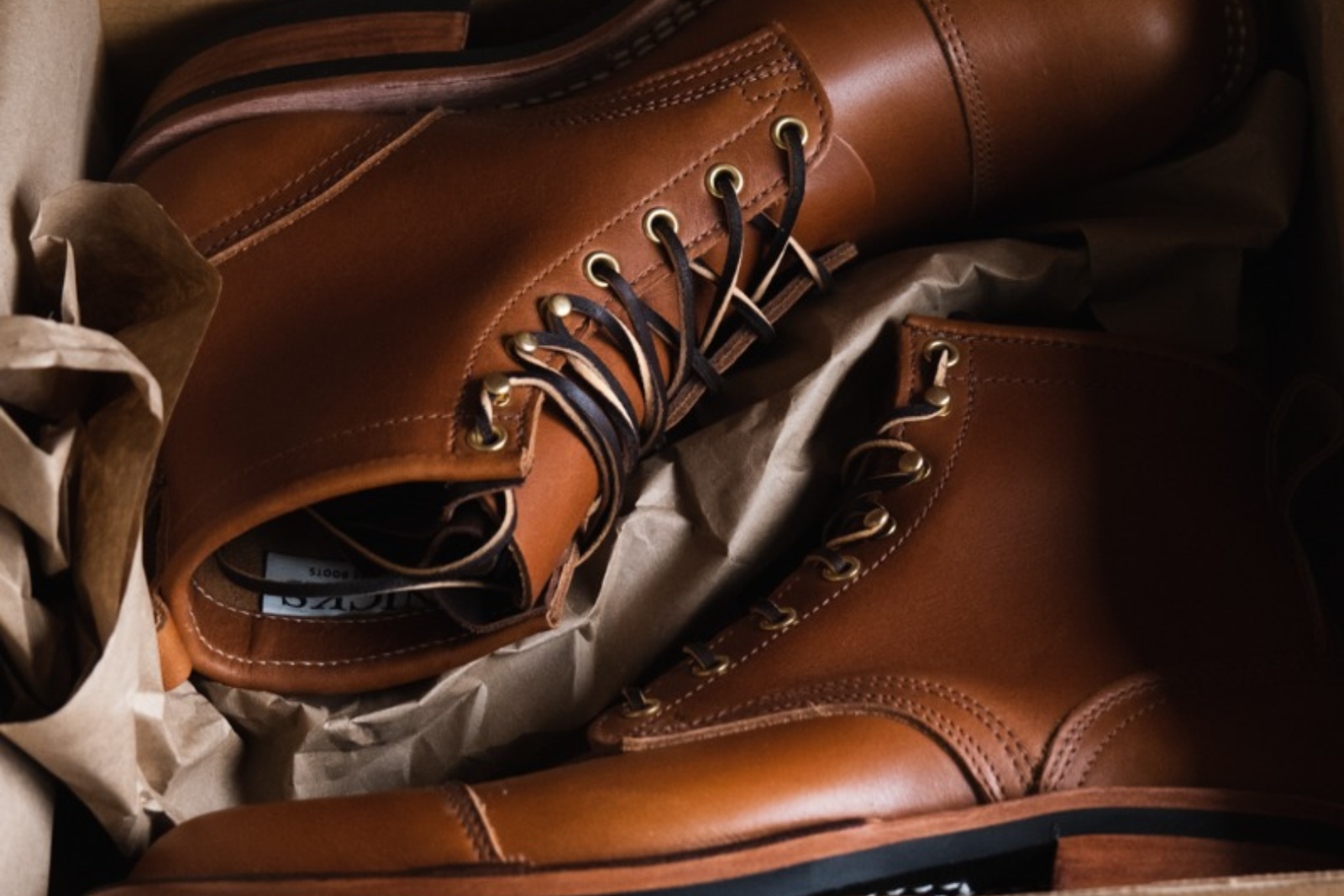Key Takeaways:
- Traditional Craftsmanship: Goodyear welt construction dates back to 1869 and is revered for the skilled craftsmanship it requires.
- Durability and Repairability: These shoes are highly valued for their robustness and the ease with which they can be resoled, greatly extending their lifespan.
- Investment in Quality: Despite the higher upfront cost, Goodyear welted shoes offer greater long-term value due to their durability and timeless style.
As industry leaders in handcrafted, high-quality boots, Nick's Boots proudly understands Goodyear welt construction, a gold standard in footwear durability and craftsmanship. Since 1964, our commitment to excellence has not only set us apart but also cemented our reputation among those who demand the best. Whether you're a boot aficionado or a first-time buyer, join us as we unpack the benefits and meticulous details of Goodyear welt construction that set these boots apart from the rest.
In this article, we'll go into the intricacies of Goodyear welt construction, discussing why it's the preferred choice for those seeking shoes that offer exceptional longevity, comfort, and ease of repair. Whether you're a first-time buyer or a seasoned collector, understanding the value of Goodyear welt construction will enhance your appreciation for footwear that’s built to last.

The Process Of Goodyear Welt Construction
The process of Goodyear welt construction is meticulous and reflects traditional craftsmanship, involving several key steps that distinguish it from other shoe construction methods. Here’s a step-by-step breakdown:
Preparation Of The Insole
The insole serves as the foundation of the shoe. A rib, which is crucial for the structure of the shoe, is either created on or securely attached to the underside of the insole. This rib is essential as it will later serve to hold all parts of the shoe together, providing a sturdy base for further assembly.
Lasting
In this stage, the shoe’s upper is carefully stretched over a form called a "last," which is essentially a mold that gives the shoe its shape. This process is vital for ensuring that the finished shoe fits comfortably. The upper is then temporarily attached to the insole, preparing it for the next stage of construction.
Welt Stitching
A key feature of the Goodyear welt process, a strip of leather known as the welt, is stitched to the upper and the insole rib. This step is fundamental because the welt serves as a stable anchor for the entire shoe, providing a strong link between the shoe's upper and its sole.
Filling
After the upper and welt are attached, the void between the insole and the bottom of the upper is filled with cork or another suitable filler material. This filler not only provides insulation and adds to the shoe's comfort but also molds to the shape of the wearer’s foot over time, creating a customized fit that enhances overall comfort.
Sole Attachment
The next major step involves stitching the outsole to the welt, which completes the main construction of the shoe. This specific method of attaching the sole ensures that it can be removed and replaced without causing damage to the upper, facilitating easier repairs and extending the life of the shoe.
Finishing Touches
The final steps in the Goodyear welt process involve detailed cleaning, polishing, and thorough inspection of the shoe to ensure it meets all quality standards. These finishing touches are crucial as they enhance the aesthetic appeal of the shoe and ensure that it is ready for use, reflecting the high standards of craftsmanship associated with Goodyear welted footwear.
Benefits Of Goodyear Welt In Footwear
The Goodyear welt construction offers several significant benefits that make it a favored choice among quality footwear enthusiasts. Here are some of the key advantages:
Durability
One of the most celebrated benefits of Goodyear welted shoes is their robust construction. The method of stitching the welt to both the upper and the sole creates a strong bond that significantly enhances the footwear's durability. This robust construction means that Goodyear welted shoes can withstand rigorous use and are less likely to come apart, making them ideal for long-term wear and demanding conditions.
Repairability
Unlike shoes that are glued together, Goodyear welted shoes can be resoled repeatedly. The welt acts as a buffer between the insole and the outsole, allowing the sole to be replaced without damaging the rest of the shoe. This feature not only extends the life of the shoes but also makes them a more sustainable footwear option, as they can be worn for many years with proper care. This ability to replace the sole is particularly beneficial for those who form an attachment to a comfortable pair of shoes and prefer to repair rather than replace them.
Water Resistance
The Goodyear welt construction method enhances the water resistance of the footwear. By creating a tight seal around the base of the shoe, this construction method effectively reduces the likelihood of water penetrating the shoe. This makes Goodyear welted shoes an excellent choice for wear in damp or wet conditions, protecting the wearer's feet and the longevity of the shoe itself.
Comfort
The inclusion of a cork filler between the insole and outsole is another significant advantage. This cork not only provides additional insulation and cushioning but also molds to the shape of the wearer’s foot over time. This process creates a personalized fit that enhances comfort, making Goodyear welted shoes feel like they are custom-fitted to the wearer's feet, thus improving overall foot health and comfort during long periods of use.
Breathability
The layered construction of Goodyear welted shoes allows for better air circulation within the shoe. This increased breathability helps in keeping the feet cooler and reducing moisture buildup, which is beneficial for foot health and comfort, especially in warmer climates or during prolonged wear.
Aesthetic Appeal
Finally, Goodyear welted shoes often feature superior craftsmanship and high-quality materials, which contribute to their aesthetic appeal and elegance. The visible stitching and the quality of the welt combine to create a distinguished and stylish look that appeals to those who appreciate classic footwear styles. This aesthetic quality, combined with durability, makes Goodyear welted shoes a popular choice among discerning customers who value both function and form in their footwear.
Comparing Goodyear Welt To Other Shoe Construction Techniques
When evaluating the merits of Goodyear welt construction, it's helpful to compare it to other common methods used in shoemaking. Here’s how Goodyear welt stacks up against other techniques:
- Cemented Construction: This is one of the most common and cost-effective methods where the sole is glued directly to the upper. While cemented shoes are generally less expensive and lighter, they lack the durability and repairability of Goodyear welted shoes.
- Blake Stitching: Similar to the Goodyear welt, Blake stitching involves sewing the upper directly to the sole, but without a welt. This results in a closer-cut sole that is less bulky and more flexible. However, the lack of a welt makes Blake stitched shoes less water-resistant and harder to resole compared to Goodyear welted shoes.
- Stitchdown Construction: In this method, the upper is flanged outwards and stitched directly to the sole, providing good durability and flexibility. Stitchdown shoes are easier to resole than cemented ones but still do not offer the same level of water resistance or longevity as Goodyear welted footwear.
- Norwegian Construction: Known for its exceptional water resistance, this technique involves an additional leather piece that makes the shoe extremely sturdy. However, shoes with Norwegian construction are typically more expensive and less common than Goodyear welted shoes.
Each construction method has its own set of benefits and trade-offs. Goodyear welt shoes are particularly valued for their durability, ease of repair, and classic aesthetic, making them a preferred choice for high-quality, long-lasting footwear.
Care And Maintenance Of Goodyear Welt Footwear
Proper care and maintenance are crucial to extend the lifespan and enhance the appearance of Goodyear welt footwear. Here are some essential tips to keep your shoes in top condition:
Regular Cleaning
Dust and dirt are inevitable but can be particularly damaging over time to the leather of shoes. It's important to regularly use a soft brush or cloth to gently remove any surface dirt before and after each wear. This simple step helps prevent the buildup of grime that can degrade the leather's quality and appearance, maintaining the shoe's aesthetic and structural integrity.
Conditioning
Leather, much like skin, requires hydration to stay supple and prevent cracking. Every few months, depending on the frequency of use and the climate in which they are worn, applying a quality leather conditioner can replenish the natural oils lost during wear. This routine maintenance keeps the leather flexible and resistant to developing cracks, thereby prolonging the life of your shoes.
Waterproofing
Despite their inherent water resistance, Goodyear welt shoes can benefit significantly from additional waterproofing treatments. Applying a waterproofing agent helps to further protect them from moisture exposure, which can be especially useful in wet climates or during seasons when precipitation is common. This not only extends the shoe’s durability but also maintains its comfort and structural integrity.
Proper Storage
The way you store your shoes can affect their longevity and shape. It's advisable to store Goodyear welt footwear in a cool, dry place and use shoe trees to maintain their shape and absorb any residual moisture within the leather. Avoid exposure to direct sunlight or extreme temperatures, which can accelerate the deterioration of the leather and cause discoloration.
Resoling
One of the standout benefits of Goodyear welt construction is the feasibility of resoling. Keeping an eye on the wear of your soles and considering resoling when they show significant wear not only refreshes the shoe but also prevents more extensive and costly repairs in the future. Regular inspection helps catch potential issues early, making resoling a practical option for maintaining the shoe’s performance and appearance.
Polishing
Regular polishing does more than just improve the shoe’s appearance—it also adds a protective layer to the leather. Using a suitable polish for the leather type not only brings out the shoe’s shine but also provides an extra layer of protection against external elements. This ritual not only keeps the shoes looking pristine but also acts as a barrier against scuffs and stains.
How To Identify Goodyear Welt Construction In Shoes
Identifying Goodyear welt construction can be crucial for those who value durability and ease of repair in their footwear. Here are some tips to help recognize this prestigious shoemaking technique:
Check The Stitching
To identify a Goodyear welt, look for visible stitching that connects the welt to the upper and the sole. This stitching is typically visible on the outside of the shoe’s outsole and may sometimes be seen on the inside as well. The presence of this stitching is a key indicator of Goodyear welt construction and signifies the robust assembly technique used.
Examine The Welt
The welt itself is a defining feature of this construction type. It is a strip of leather that runs along the perimeter of the outsole and is usually visible as it extends slightly beyond the edge of the shoe’s upper. This welt not only helps in attaching the sole to the upper securely but also contributes to the shoe's ability to be resoled.
Look For Layers
Checking the side profile of the shoe at the point where the upper and the sole meet can reveal distinct layers stacked together – typically the upper, the welt, and the sole. These layers are a hallmark of Goodyear welt construction, indicating the methodical layering and stitching that provides enhanced durability.
Feel The Flexibility And Weight
Goodyear welted shoes often have a sturdier and slightly heavier feel due to the additional materials used in the welt and the overall construction process. This makes them more robust but also gives a feeling of substantial quality that is less common in more lightly constructed footwear.
Ask for Confirmation
When in doubt about a shoe's construction, asking the retailer directly or checking the manufacturer’s specifications can provide confirmation. Many brands that use Goodyear welt construction are proud of this fact and prominently mention it as a feature due to its appeal to knowledgeable customers seeking quality and longevity.
Final Thoughts
Goodyear welt shoes represent the best in traditional shoemaking, offering durability, the ability to be repaired, and a timeless look. Though they cost more at first, these shoes are a smart purchase because they last a long time and can be resoled, which saves money in the long run compared to cheaper shoes that you throw away. These shoes not only look great, with their classic design and careful making, but they're also perfect for everyday use or special events. Choosing Goodyear welt shoes means choosing to support long-lasting fashion, quality work, and shoes that improve as they age, showing a commitment to lasting values and a thoughtful lifestyle.

Read Also:
Frequently Asked Questions About Goodyear Welt
What is the origin of the name "Goodyear Welt"?
The Goodyear welt is named after Charles Goodyear Jr., who patented the machine that made this shoe construction technique possible in 1869, not to be confused with his father, Charles Goodyear, the inventor of vulcanized rubber.
Can Goodyear welt shoes be fully waterproof?
Goodyear welt shoes are highly water-resistant due to their construction method. However, they are not entirely waterproof without additional treatment or specific waterproof materials.
Are Goodyear welted shoes suitable for all seasons?
Yes, Goodyear welted shoes are suitable for all seasons due to their durability and the ability to include insulation. Proper care, such as regular waterproofing, is recommended for harsh weather conditions.
How often should Goodyear welt shoes be resoled?
Resoling depends on wear and care but typically every 2-5 years if worn regularly. This timeframe can vary based on how often the shoes are worn and the surfaces they're used on.
Is there a break-in period for Goodyear welt shoes?
Yes, Goodyear welt shoes often have a break-in period due to their sturdy construction. The time required can vary but generally lasts a few weeks of regular wear.
Why are Goodyear welt shoes more expensive than other types?
The higher cost is due to the labor-intensive process, the quality of materials used, and the skilled craftsmanship required to construct them.
Can any cobbler resole Goodyear welt shoes?
Most cobblers are equipped to handle resoling Goodyear welt shoes, but it's best to choose one familiar with high-quality shoe construction to ensure the best results.
What types of leather are best for Goodyear welt shoes?
Full-grain and top-grain leathers are commonly used for their durability and ability to age beautifully. Exotic leather can also be used for more unique aesthetics.
Are Goodyear welt shoes heavier than other types?
Generally, they are slightly heavier due to the additional materials used in the welt and sole, contributing to their durability.
How does the Goodyear welt method affect the shoe’s fit?
The Goodyear welt construction typically results in a firmer fit initially but offers excellent support and molds to the foot's shape over time, enhancing comfort.





































